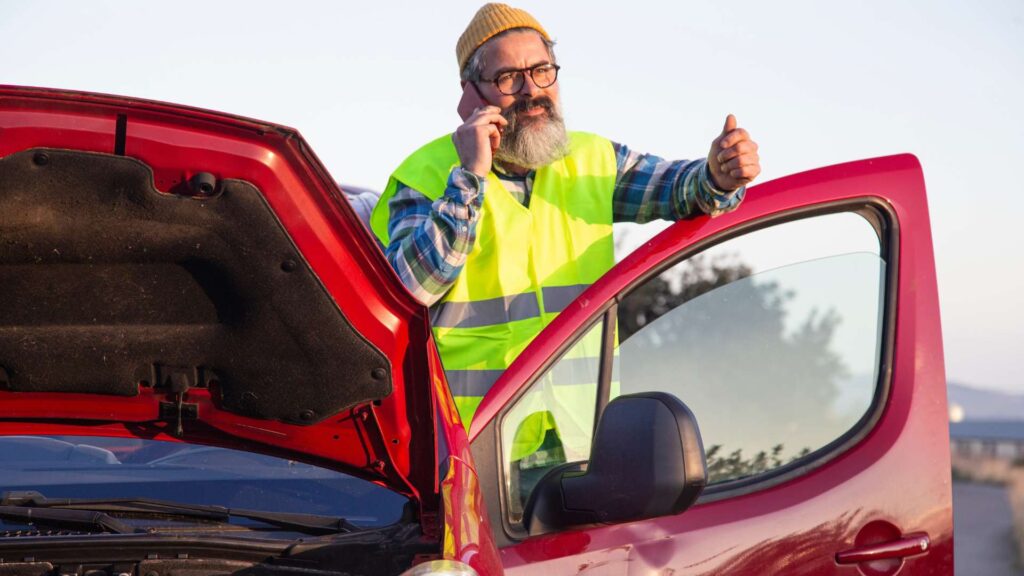Table of Contents
Getting into a car accident is stressful, no matter the circumstances. But imagine this: you’ve exchanged information with the other driver only to discover they don’t have insurance. Suddenly, your mind fills with questions. Who pays for the damages? How do you handle medical bills? And what if the other driver walks away from their responsibility?
This situation is not as rare as many people believe. According to the Insurance Research Council, about 1 in 8 drivers in the US is uninsured. The rate is higher in Florida and Mississippi. What to do if the at-fault driver is uninsured? This blog offers a step-by-step guide for such a scenario.
Immediate Steps to Take at the Accident Scene
Ensure Safety First
The priority in any accident is protecting yourself and your passengers. If possible, move vehicles to a safe location, turn on hazard lights, and check for injuries. Call 911 if anyone is hurt, no matter how minor the injuries may appear. Even if you feel fine, some injuries manifest later, so getting checked out is wise. Ensuring safety creates a clear foundation for handling everything else.
Call the Police
A police report is your strongest piece of evidence in uninsured driver accidents. It is an official record that the other driver was at fault and uninsured, which is critical when filing an uninsured motorist claim with your insurer. Even if the other driver pleads with you not to call, insist on it. Without a police report, your claim will be much harder to prove.
Gather Evidence
While waiting for the police, collect as much evidence as possible. Take photos of the damage to both cars, license plates, skid marks, and road conditions. Get the uninsured driver’s contact information, including their driver’s license number, and ask witnesses for their statements and contact details. The more evidence you gather, the stronger your claim will be later.
Avoid Confrontation
It’s easy to feel frustrated or angry, especially if the other driver admits they don’t have insurance. But arguments or accusations won’t help your case. Keep interactions polite, calm, and factual. Let the police handle the confrontation. Staying level-headed prevents worsening the situation and ensures your side of the story is credible.
Reporting and Documentation
Notify Your Insurance Company Promptly
Call your insurer as soon as possible, ideally within 24 hours. Let them know the other driver is uninsured and provide the police report number. Quick reporting allows your insurer to begin their investigation immediately, speeding up the claims process. Delays may create unnecessary complications.
Provide Full Documentation
Your insurer will need proof of the uninsured driver’s fault. Share everything you collected: the police report, scene photos, medical records, and witness information. Detailed documentation demonstrates responsibility on your part and makes it harder for your insurer to deny or reduce your claim.
Why Paper Trails Matter
Insurance companies rely on records to evaluate claims. Without proof, your word may not be enough. A thorough paper trail protects you legally, strengthens your financial recovery, and shows you correctly handled the accident.
Insurance Coverage Options That Can Protect You
Uninsured Motorist Coverage (UM)
UM coverage exists specifically to handle situations where the at-fault driver has no insurance. In some states, it covers bodily injuries such as medical bills, rehabilitation costs, lost wages, and even pain and suffering. A few states also allow UM to cover property damage. Having UM ensures you’re not left paying for injuries caused by someone else’s negligence.
Underinsured Motorist Coverage (UIM)
Not all drivers are completely uninsured—some carry only the minimum liability coverage required by law. In serious accidents, that minimum may barely cover a fraction of your expenses. UIM coverage fills the gap when the other driver’s policy isn’t enough. For example, your UIM policy can cover the difference if your medical bills total $60,000 and your liability limit is $25,000.
Collision Coverage
Collision coverage pays for repairs to your own vehicle regardless of fault. If an uninsured driver hits you, collision coverage ensures your car is repaired or replaced without waiting for reimbursement from another party. While it doesn’t cover medical bills, it’s essential for avoiding large repair costs.
Medical Payments (MedPay) or Personal Injury Protection (PIP)
MedPay and PIP provide medical coverage for you and your passengers, regardless of fault. PIP is mandatory in no-fault states, while MedPay is optional elsewhere. These coverages help pay for doctor visits, hospital stays, and related expenses. They also provide quick financial relief because they often kick in before liability is determined.
Legal Options After an Accident with an Uninsured Driver
Filing a Lawsuit
You can sue the at-fault driver personally for damages. However, success depends on whether they have the assets to pay. Often, uninsured drivers lack the financial means to cover judgments. Even if you win in court, collecting may be challenging, so insurance coverage is a far more reliable option.

Small Claims Court
For smaller expenses, such as a few thousand dollars in repairs or medical bills, small claims court may be worth pursuing. It allows you to present your case without hiring a lawyer, keeping costs down. Still, payment enforcement can be difficult if the uninsured driver has no resources.
State Compensation Programs
Some states maintain uninsured motorist funds to help victims of uninsured accidents. These programs vary, and not all states offer them. Typically, they provide limited compensation and require proof of the other driver’s uninsured status. Checking your state’s Department of Insurance can tell you if such a program exists where you live.
Financial and Practical Implications
Out-of-Pocket Costs Without UM/UIM
The financial consequences can be severe if you don’t carry uninsured or underinsured coverage. You may have to pay for car repairs, medical bills, lost income, and legal fees yourself. A minor accident can cost thousands, while a major crash could put you in significant debt.
Impact on Your Premiums
Even though the accident wasn’t your fault, filing a claim under your policy can sometimes increase premiums. Some insurers treat UM/UIM claims differently, but not all of them. It’s worth asking your provider how they handle these claims in your state.
Long-Term Considerations
Beyond immediate costs, serious injuries can lead to ongoing medical treatment, reduced ability to work, or even permanent disability. Without the right coverage, the long-term financial impact can be devastating, affecting your and your family’s financial stability.
How to Prepare Before an Accident Happens
Review Your Policy Regularly
Make it a habit to review your auto insurance policy at least once a year. Confirm that you have UM and UIM coverage and the limits are high enough to protect you in a serious accident. Many people discover that they declined this coverage too late to save a few dollars.
Understand State Requirements
Every state has its own rules. About 20 states require UM/UIM coverage, but others make it optional. If your state doesn’t mandate it, it’s still worth purchasing. Knowing your state’s requirements ensures you’re not left with gaps in coverage.
Consider Higher Coverage Limits
UM and UIM are relatively inexpensive compared to the protection they provide. Raising your coverage from $25,000 to $100,000 often adds just a few dollars a month but could save you tens of thousands in an uninsured accident.
Explore Tools and Apps
Digital comparison tools and apps allow you to shop for coverage quickly and see if you’re missing protections. They also make it easy to check whether your policy includes UM/UIM and compare options for raising limits affordably.
Common Mistakes to Avoid in Uninsured Accidents
Accepting Cash at the Scene
Uninsured drivers may offer to pay you cash on the spot to avoid legal trouble. This is risky. Hidden vehicle damage or delayed medical symptoms can cost much more than they appear. Always refuse cash and insist on proper reporting.
Failing to Call the Police
Without a police report, your insurer may deny your uninsured motorist claim. Never agree to handle things “privately.” A formal record is essential for proving fault and lack of coverage.
Not Notifying Your Insurer
Some drivers hesitate to call their insurance company, fearing premium increases. But failing to notify your insurer can jeopardize your claim. Even if you don’t intend to file immediately, reporting ensures the accident is documented.
Assuming Health Insurance Is Enough
Health insurance may cover medical care, but won’t pay for lost wages, property damage, or pain and suffering. Relying only on health coverage leaves you financially exposed.
Conclusion
Being hit by an uninsured driver is one of the most frustrating situations. It adds uncertainty and financial risk to an already stressful event. But knowing the right steps to take can make all the difference. At the scene, focus on safety, call the police, and document everything. Notify your insurer quickly and provide all evidence to support your claim. Lean on coverages like UM, UIM, collision, and MedPay to fill in the gaps left by the other driver’s lack of insurance.
If necessary, explore legal options like small claims court or state compensation programs, though insurance coverage remains the most reliable solution. Beem, the personal finance app trusted by over 5 million Americans, provides a convenient platform for comparing car insurance quotes and discovering affordable rates tailored to individual needs. Take the first step towards securing reliable coverage with Beem. Download the app here.
FAQs for What to Do if the At-Fault Driver is Uninsured
What percentage of drivers are uninsured in my state?
Nationally, about 12–13% of drivers lack insurance, but state rates vary widely. In states like Florida, nearly one in four drivers is uninsured, while in states like Massachusetts, fewer than one in 5 drivers is uninsured.
Will my insurance rates go up if I use UM coverage?
It depends on the insurer. Some companies treat UM claims like not-at-fault accidents and don’t raise rates. Others may increase premiums slightly. Ask your insurer how UM claims are handled in your state before filing.
Can I sue an uninsured driver if they caused serious injuries?
Yes, but recovery is often difficult. Many uninsured drivers lack assets, which makes collecting damages challenging even if you win in court. Lawsuits can provide accountability but may not guarantee compensation.
Is UM coverage mandatory in all states?
No. About 20 states require UM/UIM coverage, while the rest leave it optional. Regardless of the law, carrying it is highly recommended to protect yourself financially.
How much UM/UIM coverage should I carry?
Most experts recommend carrying limits that match your liability coverage. For example, if you carry $100,000 liability per person, you should match it with $100,000 UM/UIM coverage. This ensures you’re equally protected against others’ negligence as you are against your own mistakes.















































